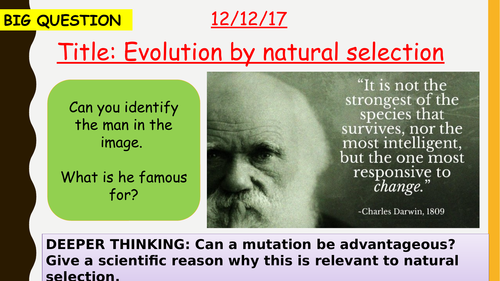
Evolution by natural selection lesson created in accordance to the NEW AQA Specification (9-1). Designed for higher ability (trilogy/combined) class, although content can be adjusted to suit any ability. Includes: embedded videos and timers, slide animations, practice questions with answers on slides and an interactive quiz. NB: If you are unable to play videos a URL link can be found in the slide notes.
AQA spec link: 4.6.2.1 + 4.6.2.2
Relevant chapter: B13 Variation and evolution. AQA Biology trilogy edition textbook-Page 180-181.
Students are required to know the following;
Students should be able to:
• state that there is usually extensive genetic variation within a population of a species
• recall that all variants arise from mutations and that: most have no effect on the phenotype; some influence phenotype; very few determine phenotype.
Mutations occur continuously. Very rarely a mutation will lead to a new phenotype. If the new phenotype is suited to an environmental change it can lead to a relatively rapid change in the species.
Students should be able to describe evolution as a change in the inherited characteristics of a population over time through a process of natural selection which may result in the formation of a new species.
The theory of evolution by natural selection states that all species of living things have evolved from simple life forms that first developed more than three billion years ago.
Students should be able to explain how evolution occurs through natural selection of variants that give rise to phenotypes best suited to their environment.
If two populations of one species become so different in phenotype that they can no longer interbreed to produce fertile offspring they have formed two new species.
AQA spec link: 4.6.2.1 + 4.6.2.2
Relevant chapter: B13 Variation and evolution. AQA Biology trilogy edition textbook-Page 180-181.
Students are required to know the following;
Students should be able to:
• state that there is usually extensive genetic variation within a population of a species
• recall that all variants arise from mutations and that: most have no effect on the phenotype; some influence phenotype; very few determine phenotype.
Mutations occur continuously. Very rarely a mutation will lead to a new phenotype. If the new phenotype is suited to an environmental change it can lead to a relatively rapid change in the species.
Students should be able to describe evolution as a change in the inherited characteristics of a population over time through a process of natural selection which may result in the formation of a new species.
The theory of evolution by natural selection states that all species of living things have evolved from simple life forms that first developed more than three billion years ago.
Students should be able to explain how evolution occurs through natural selection of variants that give rise to phenotypes best suited to their environment.
If two populations of one species become so different in phenotype that they can no longer interbreed to produce fertile offspring they have formed two new species.
Get this resource as part of a bundle and save up to 20%
A bundle is a package of resources grouped together to teach a particular topic, or a series of lessons, in one place.
Something went wrong, please try again later.
Saved me so much time today, thank you! Great examples to use with my class.
Report this resourceto let us know if it violates our terms and conditions.
Our customer service team will review your report and will be in touch.
£4.00
